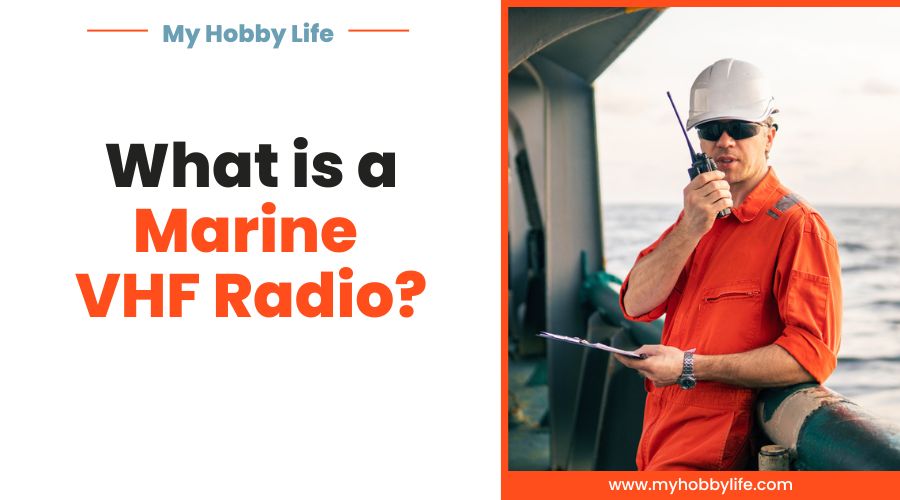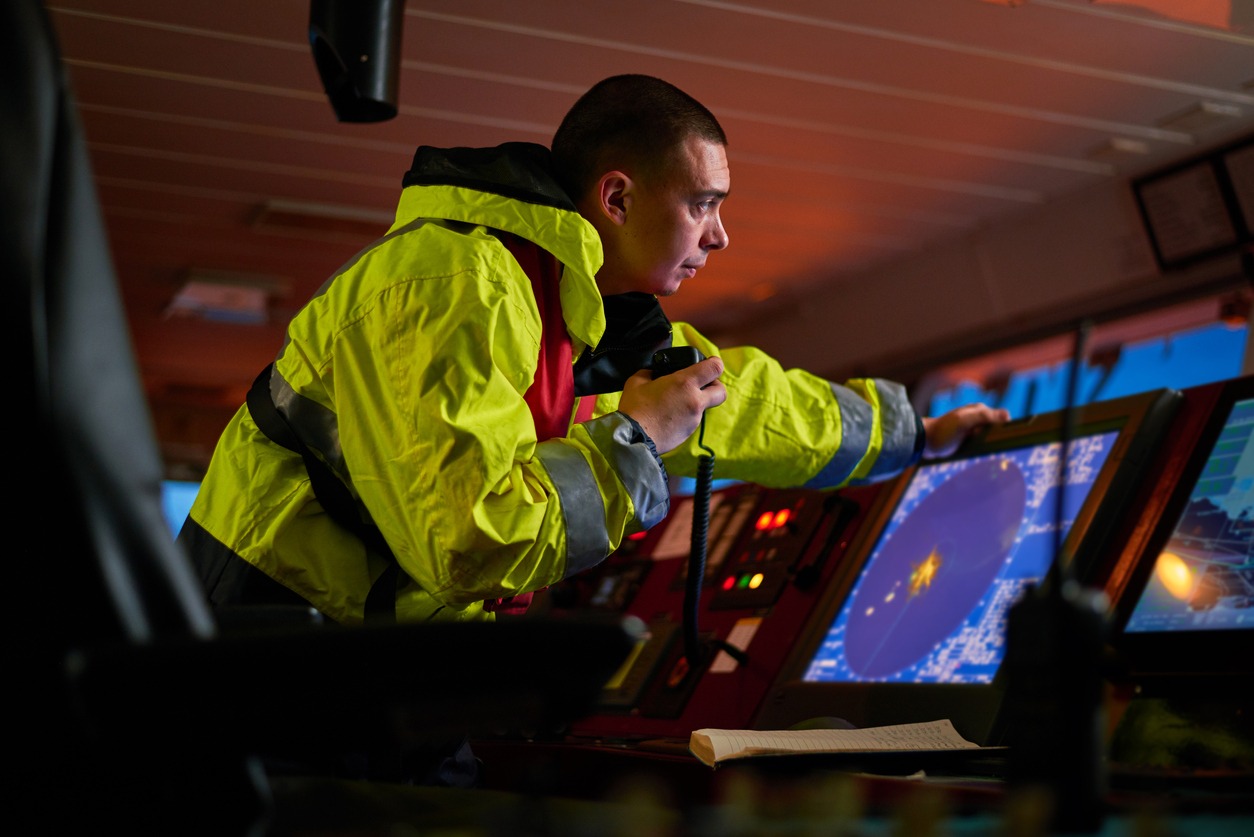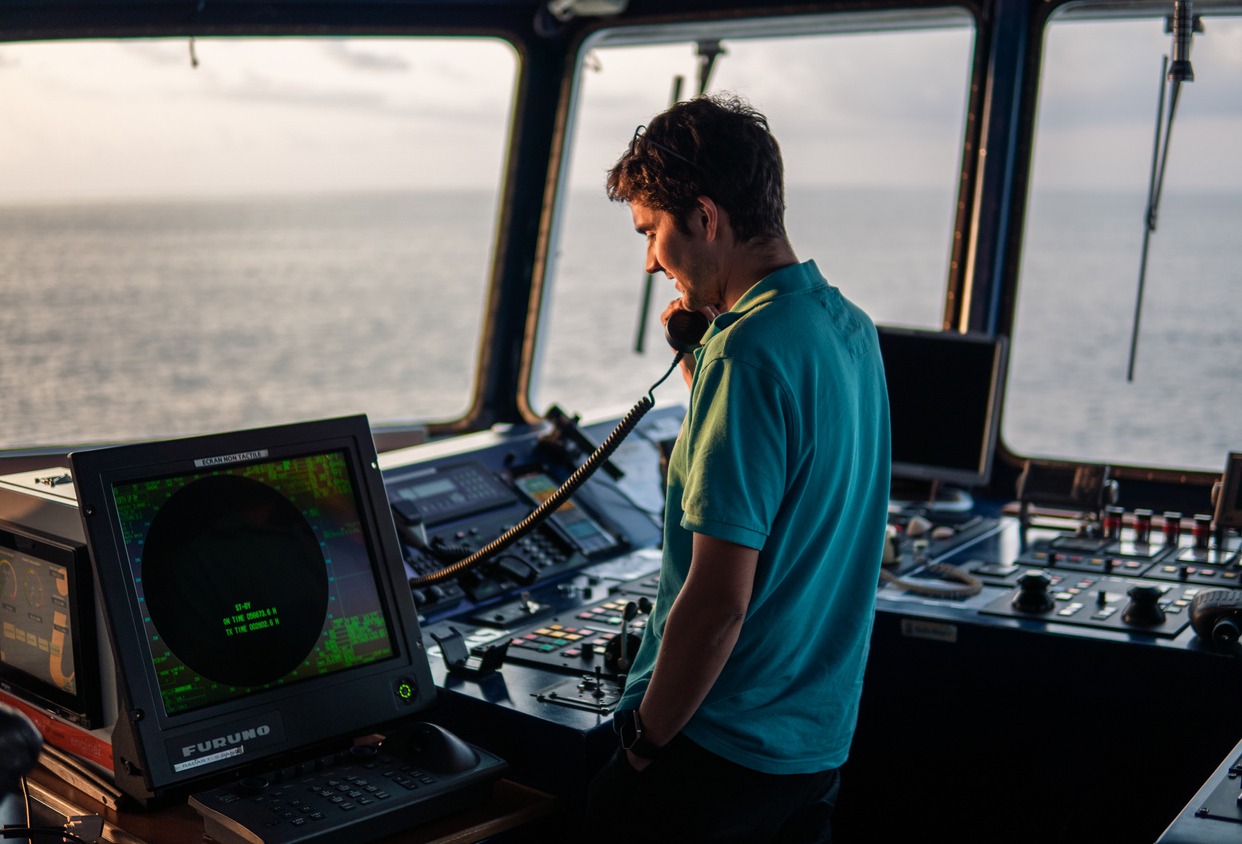Descriptive Alt Tag: Marine Deck Officer or Chief mate on deck of offshore vessel or ship , wearing PPE personal protective equipment – helmet, coverall. He reports on VHF walkie-talkie radio in hands.
Accidents and emergencies happen on the water, just like they do happen on land. Whether a casual boater or a seagoing professional, you need a marine VHF radio. Radio communication is an integral part of your voyage experience or in your boating.
A Marine VHF radio or very-high frequency radio is a communication device with a worldwide system of two-way radio transceivers. Ships and watercraft are using this VHF radio for bidirectional voice communication from ship-to-ship, ship-to-shore, and in certain conditions ship-to-aircraft. It has a VHF antenna that transmits high-frequency waves, measured in MHz. VHF radio can range up to 30 nautical miles if the antenna is high enough. It uses FM channels in the very high frequency (VHF) radio band in the frequency range between 156 and 174 MHz inclusive. But for some countries, it uses additional channels for leisure and fishing vessels.
This VHF radio allows instant communication between your boat and other boats, marinas, and coast guards. It is the primary means of communication on coastal waters and has many characteristics which make it preferable to a cell phone, CB Radio, or other means of communication. Most VHF Marine Radios also have instant access to weather forecasts 24 hours a day.
History
In the 1890s, Guglielmo Marconi invented radio communication. And at the beginning of 1900, the Marconi Company installed wireless telegraphy stations on ships. It was then that marine radio was the first commercial application of radio technology, allowing ships to keep in touch with shore and other ships, and send out a distress call for rescue in case of emergency.
In 1904, Marconi established the first Morse code distress call. The letters CQD were used until 1906, when SOS was agreed on.
The first significant marine rescue due to radio was when 1,500 lives were saved in the 1909 sinking of the luxury liner RMS Republic. This event and the 1912 RMS Titanic rescue brought the field of marine radio to public consciousness.
During World War I, amplitude modulation was developed in which the first marine radio transmitters used longwave bands. In the 1920s, the spark radiotelegraphy equipment was replaced by vacuum tube radiotelephony allowing voice communication. Also, in the 1920s, the ionospheric skip or skywave phenomenon was discovered, which allowed lower-power vacuum tube transmitters operating in the shortwave bands to communicate at long distances.
Types
Marine VHF radios come in two main types, handheld and fixed. Some have an inbuilt Global Positioning System (GPS) receiver and an Automatic Identification System (AIS) receiver.
Handheld or Portable
Handheld radios are best for smaller boats because they are portable and battery-operated to facilitate power transmission. A handheld VHF radio has waterproof coverings, so it can float and still function even if they fall into the water.
Handheld VHF radios have a compact size making them more portable during emergencies. They have a 5-mile restricted range, and when you use a rechargeable lithium-ion battery in them, they will be able to provide a longer battery life.
Fixed or Non-Portable
Fixed or non-portable VHF marine radios, on the other hand, are designed for bigger boats and cover a lot of aerial ground. Their power transmission and energy source are enormous compared to their portable counterparts and are far more feasible regarding their operational facilities. They can also ensure better communication because they can be set up as dual stations and navigate using GPS, and you can install a microphone.
Also, fixed radios offer the Digital Selective Calling or DSC feature, which enables you to alert other boats, shore stations, and rescue boats at the press of a button. To take maximum advantage of DSC radio, one should have a Maritime Mobile Service Identity or MMSI number, which can help you to connect with other vessels in the vicinity.
Channels and Frequencies
A marine VHF set is a combined transmitter and receiver and only operates on standard, international frequencies known as channels.
Channel 9
The primary calling channel is where you can establish contact on this channel and move to a working channel as soon as possible.
Channel 16
This channel is for international distress and safety calls. It is for emergency and distress calls only.
Channel 13
This channel provides bridge-to-bridge communications between vessels. It is a channel to listen to in periods of poor visibility so you can communicate with ferries, freighters, and other large vessels.
Channels 68, 69, 71, 72, 78A
They are called the working channels. The only channels are available to non-commercial vessels for ship-to-ship and ship-to-shore communications.
In addition, the frequencies, channels, and some of their purposes are controlled by the International Telecommunication Union. The original allocation of channels consisted of only channels 1 to 28 with 50 kHz spacing between channels, and the second frequency for full-duplex operation is 4.6 MHz higher.
How to Use a Marine VHF Radio?
Below is a standard procedure for a non-emergency call. For example, calling another vessel, marina, or restaurant to ask where to have dinner are as follows.
- Call the vessel, marina, or restaurant on Channel 9 in the following manner.
- Say the name of the station you are calling three times.
- Say the phrase THIS IS once.
- Name of your vessel spoken once.
- Then, the word OVER.
- You wait for the station to answer. Their answer should be in the same manner as your call.
- Once answered, you can suggest a specific working channel for your conversation.
- Then, the word OVER.
- Wait for a reply or confirmation, and switch to the working channel once agreed.
- Say OUT at the end when done speaking and leaving a specific channel.
When using a VHF Radio during an emergency, tune it to channel 16. If your life is in danger, you can make a distress call by saying “Mayday Mayday Mayday,” the name of the vessel and call sign. After the coast guard responds, reply with the position, ideally with your latitude and longitude from the GPS. A rescue boat can find you easily if the distress call offers complete information.
Note that the word MAYDAY is to be used ONLY in an emergency. It may be in a situation in which the boat and/or persons on board are in imminent danger of sinking or major injury or death. You may only have seconds to send a distress call.
If you are not in a life-threatening situation but not in the best position, say pan-pan. You can give additional information such as location from GPS, vessel movement, speed, destination and number of people requiring medical attention, the color hull, cabin, etc. Wait for a reply and confirmation. Repeat in intervals if you do not receive an answer from the other side.
In conclusion, having marine VHF radios can give a sense of safety and security in your boating adventure and travel. Using VHF radios, you can call anybody because they tend to have reliable network coverage, even in places with a poor network.


